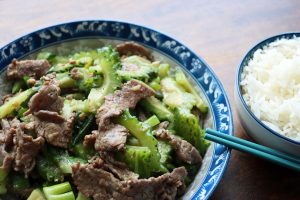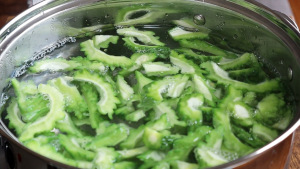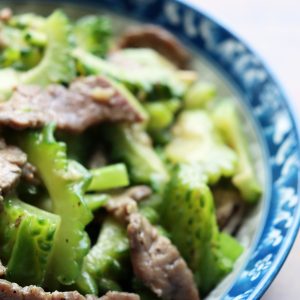Beef with Bitter Melon Stir Fry (Khổ Qua Xào Thịt Bò)

Beef with Bitter Melon Stir Fry (Khổ Qua Xào Thịt Bò) is a beloved dish at Asian family dinners. It’s easy to prepare, requires minimal ingredients, and is quite forgiving in the kitchen. The slight bitterness and crisp texture of the bitter melon, combined with tender beef, create a harmonious flavour profile that pairs perfectly with a bowl of hot steamed rice.
In the Chinese version, black bean sauce is commonly used, while the Vietnamese variation I grew up with omits this sauce.
Here are a few notes on my beef with bitter melon stir fry recipe:
- I mix a small amount of baking powder with the beef during the marinating process to help keep it tender.
- I blanch the bitter melon before cooking. Since stir-frying should be quick, blanching the bitter melon ensures it’s cooked through yet remains slightly crunchy. Blanching is also an effective way to reduce bitterness.
Q&As on Beef with Bitter Melon Stir Fry
1. Is bitter melon good for you?
Yes, bitter melon is indeed good for you and offers several health benefits:

Nutrient-Rich: Bitter melon is packed with vitamins and minerals, including vitamin C, vitamin A, folate, potassium, and iron. These nutrients contribute to overall health and well-being.
Blood Sugar Regulation: It has been shown to help lower blood sugar levels and improve insulin sensitivity, which can be beneficial for individuals with diabetes or those looking to manage their blood sugar levels.
Digestive Health: Bitter melon contains dietary fibre, which aids in digestion and helps prevent constipation. It also has compounds that support a healthy digestive tract.
Antioxidant Properties: It is rich in antioxidants, which help combat oxidative stress and may reduce inflammation and the risk of chronic diseases.
Immune Support: The high vitamin C content in bitter melon supports the immune system, helping the body fight off infections and illnesses.
Weight Management: Low in calories and high in fibre, bitter melon can be a great addition to a weight management plan as it promotes a feeling of fullness and helps control appetite.
2. What are some of the most common types of bitter melons?
Bitter melons come in several varieties, each with its own unique characteristics. Here are some of the most common types:
- Asian Bitter Melon (Momordica charantia): This is the most widely known type, commonly used in Asian cuisine. It has a wrinkled, bumpy skin and a distinct bitter flavour. It can be found in both green and yellow varieties.
- Indian Bitter Melon: Often referred to as “Karela” in India, this variety is known for its elongated, ridged appearance and pronounced bitterness. It’s a staple in Indian cooking and is often used in curries and stir-fries.
- Chinese Bitter Melon: This type typically has a more rounded shape with less pronounced ridges compared to its Indian counterpart. It is commonly used in Chinese dishes like stir-fries and soups.
- Japanese Bitter Melon (Goya): This variety is slightly less bitter and has a more elongated shape with deep ridges. It is a popular ingredient in Okinawan cuisine, particularly in dishes like Goya Champuru.
- African Bitter Melon: Known for its smaller size and slightly different shape, this variety is commonly used in traditional African dishes. It tends to be very bitter and is used sparingly.
Each type of bitter melon can vary in bitterness, size, and appearance, but all offer the distinctive flavour and health benefits that bitter melon is known for.
3. How do I lessen the bitter taste in bitter melons?

The bitter taste of bitter melon can be quite strong, but there are several methods to reduce its bitterness:
- Salting and Rinsing: Slice the bitter melon and sprinkle it with a generous amount of salt. Let it sit for about 30 minutes. The salt draws out some of the bitterness. Afterwards, rinse the bitter melon thoroughly under cold water to remove the excess salt and bitterness.
- Blanching: Blanching is an effective way to reduce bitterness. Boil the sliced bitter melon for a few minutes, then immediately transfer it to an ice bath to stop the cooking process. This can help to mellow the bitter flavour while preserving the texture.
- Soaking: Soak the bitter melon slices in cold water for about 30 minutes before cooking. This method can help to leach out some of the bitterness.
- Using Sweet or Savoury Ingredients: When cooking bitter melon, balance the bitterness by adding sweet or savoury ingredients such as onions, garlic, or a touch of sugar. This can help to counteract the bitterness and enhance the overall flavour of the dish.
- Marinating: Marinate the bitter melon slices in a mixture of soy sauce, vinegar, or citrus juice. The acid can help to cut through the bitterness and add a different flavour profile.
- Cooking with Other Ingredients: Pairing bitter melon with other ingredients that have strong or contrasting flavours, such as spicy or umami-rich foods, can help to balance the bitterness.

4. What are some of the other dishes I can make with bitter melons?
Bitter melons are quite versatile and can be used in a variety of dishes across different cuisines. Here are some popular dishes you can make with bitter melons:
- Bitter Melon Stir Fry: A common and simple preparation where bitter melon is stir-fried with meat (such as beef, pork, or chicken), garlic, and other vegetables. The dish often features soy sauce or other seasonings to balance the bitterness.
- Bitter Melon Soup: This can be a soothing and nourishing option. Bitter melon is simmered with ingredients like pork ribs or chicken, along with herbs and seasonings, to create a flavourful and comforting soup.
- Bitter Melon Stuffed with Minced Meat: The bitter melon is hollowed out and stuffed with a mixture of minced meat (usually pork or beef), rice, and seasonings. It’s then steamed or braised until tender.
- Bitter Melon Salad: Thinly sliced bitter melon can be used in salads, often combined with ingredients like tomatoes, onions, and a tangy dressing to complement its bitterness. This is popular in some Asian cuisines.
- Bitter Melon Pickles: Bitter melon can be pickled with vinegar, sugar, and spices to create a tangy, crunchy condiment that can be enjoyed with various dishes.
- Bitter Melon Juice or Smoothies: For a more adventurous approach, bitter melon can be blended into juices or smoothies. It’s often combined with fruits or vegetables to balance its strong flavour.
- Bitter Melon Omelette: Bitter melon slices can be added to omelettes or scrambled eggs for a nutritious and flavourful twist.
5. How do you say “Beef with Bitter Melon Stir Fry” in Vietnamese, and how do you pronounce it?
In Vietnamese, “Beef with Bitter Melon Stir Fry” is called “Khổ Qua Xào Thịt Bò”.
Pronunciation:
- Khổ Qua (bitter melon) – Pronounced like “khaw kwah” with a short “kh” sound and a soft “kwah” sound.
- Xào (stir fry) – Pronounced like “sao” with a rising tone, similar to saying “sow” in English but with a higher pitch.
- Thịt Bò (beef) – Pronounced like “tit baw” with a soft “t” and “baw” rhyming with “saw.”
Together, it sounds like “khaw kwah sow tit baw.”

Recipe for Beef with Bitter Melon Stir Fry (Khổ Qua Xào Thịt Bò)
Equipment
- 1 medium pot for blanching the bitter melon
- 1 medium frying pan
Ingredients
- 300 grams flank steak (sliced into bite-sized pieces)
- 3 medium bitter melons
- Freshly ground garlic
- Green onions
- 1 tablespoon oyster sauce (mixed with a bit of water)
- For seasoning: Salt, ground pepper, MSG (or chicken bouillon powder)
Instructions
- Start by seasoning the steak with salt, ground pepper, and MSG (or chicken bouillon powder) to enhance its flavour. Add a small amount of baking powder to the mix, which helps to keep the meat tender. Make sure to coat the steak evenly with the seasonings and let it marinate for at least 15-30 minutes to absorb the flavours.
- Add a bit of freshly ground garlic to the steak and mix thoroughly to ensure that its aroma and flavour are well incorporated.
- Cut the bitter melons in half lengthwise. Using a spoon, scoop out the seeds and inner pith.
- Once the bitter melons are cleaned, slice them into bite-sized pieces.
- In a pot, bring a generous amount of water to a rolling boil. Add a pinch of salt to the boiling water.
- Add the sliced bitter melons to the boiling water. Let them blanch for about 3-5 minutes. The goal is to soften them slightly while keeping them crisp and retaining their bright green colour.
- After blanching, quickly transfer the bitter melons to a bowl filled with cold water. Allow them to cool for about 10 minutes. This stops the cooking process and helps maintain their crunchiness. Drain the bitter melons thoroughly once cooled.
- Chop the green onions into small, even pieces. These will be added at the end for a fresh, aromatic touch.
- In a frying pan, heat a small amount of cooking oil over medium-high heat. Once the oil is hot, add the remaining minced garlic. Sauté the garlic until it becomes fragrant and golden brown.
- Add the marinated beef pieces to the hot pan. Stir continuously to ensure that the beef cooks evenly and begins to brown.
- When the beef is almost cooked to a medium doneness, add the blanched bitter melons to the pan. Stir well to mix the bitter melon with the beef and allow the flavours to meld.
- Sprinkle a little salt over the mixture and pour in the oyster sauce mixture. Stir everything together so that the beef and bitter melon are evenly coated with the sauce.
- Turn off the heat. Add the chopped green onions to the pan and give it a final stir to combine. The residual heat will soften the green onions slightly, adding a fresh and crisp element to the dish.
- The beef and bitter melon stir-fry is now ready to be served. Transfer it to a serving dish and enjoy hot, either on its own or with a bowl of steamed rice.

